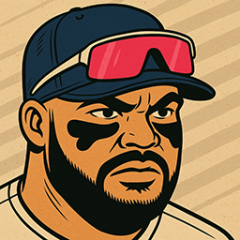-
Posts
8108 -
Joined
-
Days Won
42
Content Type
Profiles
Forums
Downloads
Everything posted by Kccitystar
-

SMB4 League Import Tool (LIT) available now!
Kccitystar replied to Kccitystar's topic in Super Mega Baseball
Had to pay my respects -
The SMB4 League Import Tool is designed to import, register, and manage custom leagues for Super Mega Baseball 4. What took so long? Well, Super Mega Baseball 4 completely changed how custom content is stored, loaded, and organized. What exactly does this tool do? Well, the tool is designed to look for a folder containing master.sav and your league saves, then decompress them into sqlite databases it can write changes to. The league .sav files also get decompressed into sqlite databases so that the tool can pull the GUID and league names from those files and present them in the data table. What it does when you register/unregister a league is just add/remove rows from the t_league_savedatas table in the master.sqlite file it created from decompressing your .sav to make those changes. When you're done making changes (i.e. clicking "Save Changes") it writes the changes to the sqlite database and recompresses the sqlite databases back to .sav format. For some background, in SMB3, there was this monolithic savedata.sav file where the Super Mega League is embedded directly inside it, and there was a giant pool of custom teams you could generate/import/export, and you can assign those teams to any custom league template the game can generate. It’s like the idea with SMB2 and 3 was to build an SMB-verse and every custom team was just another asset living inside that big sandbox. You had one save, one pool, and the game let you rearrange the pieces however you wanted. This is what made a lot of the tools simple to build and import things like full teams, and logos, etc, because it was all bound to a single save and you were just swapping pieces around in a single unified SMB-verse. The way they approached SMB4 is a game design choice more akin to OOTP or FHM, where the game is just a platform where the leagues are loaded into. The leagues are all self-contained universes and not just a collection of parts, which is why you now have a master.sav and league-(GUID).sav files. The master.sav file just catalogs which leagues exist in the game and ensures that the metadata/GUIDs correspond with what the game provides by default, like shapes, logos, icons and the three leagues (SMB, Legends and Creators Classic). The league saves are all basically isolated ecosystems. The teams, logos, players, rosters, schedules, etc are all self-contained. As I'm finally able to dig into these things in my spare time, I'm going to try and figure out ways/build some tools to migrate some things from SMB3 to 4 properly. The data is pretty consistent in moving logos 1:1 for example.
-
Version 0.16
143 downloads
About This File The SMB4 League Import Tool (LIT) is a utility designed to help players manage custom leagues and franchise saves for Super Mega Baseball 4. LIT reads your SMB4 save directory, detects all master.sav and league-*.sav files, and shows which leagues are registered for use in the game. With a simple checkbox, you can register or unregister leagues, allowing SMB4 to load exactly the ones you want. The tool also supports exporting individual league-*.sav files for sharing with other players, as well as warning you if a registered entry is missing its corresponding save file. All changes to master.sav are handled safely and cleanly: - Correct league GUID formatting - Default leagues ordered and protected - No duplicate or invalid entries - Clear before/after registration counts NOTE: LIT does not modify the content of league files themselves, it only updates SMB4’s league registration table. All temporary files created during decompression are removed automatically when the tool closes. Use this tool to keep your SMB4 save environment organized, clean, and ready for custom league play.- 1 comment
-
- super mega baseball
- editor
-
(and 1 more)
Tagged with:
-

MVPstudio06 / MVPstudio 3 / MVPedit ERRORS f20.dll / gfxpack.exe
Kccitystar replied to TBJ1977's topic in Support
I don't mean to discourage anyone from modding, but these utilities are very old and rely on libraries/dependencies that were specific to Windows XP or even 7 at the time. It can be very hard to try and get it up and running on a modern OS and there's no guarantee it'll work consistently -
Jasson was underutilized this year because Grisham had a breakout season and there was no way they were going to sit or DH anyone named Stanton, Bellinger, Grisham or Judge in the lineup to give him reps if everyone is hot at the same time, which they were for a good chunk of the season. On the flipside, there's a rumor that the Yankees are going to allow him to play winter ball in the Dominican league (LIDOM) to get his reps and be fresh by Spring Training, which I am 100% for as a way of compensating for lost playing time. I still have faith that he's a part of the Yankees' long term plans should Grisham or Bellinger move on to another team for 2026.
-
Lupica is already addressing what so many in the new york sports media have circled the block on but can't say out loud: the Yankees aren’t victims of bad luck or a playoff “crapshoot.” Their structure produces this result by design. After 2016, everything in the Yankees’ organization, from analytics, scouting, player development, to even strength and conditioning was centralized under the front office. The idea was to modernize and eliminate volatility, and surprise, it worked. The Yankees became baseball’s model of sustainability. They never collapse. They’re too rich, too organized, too deep for that. But in the process, they built a structure that protects the floor and limits the ceiling. They stopped chasing dominance and started managing risk. That’s why every October feels the same. Because it is. They are, in every sense, the definition of profitable but elite mediocrity. A perfectly functional franchise that values relevance over resonance. YES Network ratings stay high. Merch moves. The brand stays pristine. The message from the top? “We’re always competitive.” But that mindset, sustainable contention, is really just a soft landing for underachievement. The Yankees have mistaken consistency for greatness. They’ve built a system so resistant to failure that it can no longer succeed beyond expectation. Every year, it’s the same pattern: power over approach, data over instinct, process over feel. The Yankees assemble 90-win rosters, but they don’t build teams. That’s the identity crisis. There’s no fire, no adaptability, no soul. And fans will delusionally tell you this offseason needs “one big move”, a Kyle Tucker, a statement signing, a splash, but this isn’t a “one player away” problem. It’s cultural. Every offseason turns into “one more piece, trust me bro” while the foundation remains unchanged. As long as the philosophy stays the same: centralized control, process worship, risk aversion, we will see the same outcomes year over year.
-

Ask Me Anything: I work at the Worldwide Leader
Kccitystar replied to BallFour's topic in Left Field (Off-Topic)
12 years is a long time brother! I'll throw something in your wheelhouse you can probably answer: As a fan of MLB like the rest of us, you've probably been fully aware of the pacing of MLB games changing dramatically on the field, with the pitch clock, disengagement limits, and other rule changes within your time at "The Worldwide Leader". At the same time, stadiums are filling more of the ‘dead ball’ gaps with noise and entertainment to keep fans engaged. So, from a broadcast standpoint, how have those two forces changed how you and your team approach pacing a TV broadcast? Are you finding less flexibility for commercial breaks, storytelling, or graphic packages compared to before? How does this compare to other sports if you cover those as well? -
moved to mvp baseball 2005 > support
-
The thing about Judge was that he initially followed the system. The Yankees emphasized contact, short swings, “stay up the middle.” His size and natural leverage clashed with that. He had strikeout issues and inconsistent contact in the minors, and there were doubts whether he’d make enough contact to succeed in MLB. Some in the sports media world thought he would be an AAAA bust in 2016. In his first call-up, Judge struck out 42 times in 84 plate appearances. This was the red flag for him. The Yankees’ “shorten up” mantra wasn’t solving the issue. It was treating the symptom, not the cause. Judge is described as being meticulous and self-analytical, so after that disastrous debut, he didn’t just wait for the Yankees to fix him. He researched alternatives and found Richard Schenck ("Teacherman"), a coach pushing mechanics rooted in rotational power and bat-path efficiency, basically the opposite of the organizational teaching. See, the problem with the Yankees is that on the hitting side, they've been successful at producing MLB contributors: Rice, Bird, Wells, Dominguez, Cabrera, even Volpe despite the struggles, but not enough impact players. I'm fully convinced this is intentional/by design based on their approach to develop guys into a safe, low-ceiling template. Judge has been the only one to break through to become a bonafide star since Robinson Cano, who also improved outside of the Yankees' system. On the pitching side it's the complete opposite, mainly because pitching development under Blake gives guys individualized plans, their team tailors guys to strengths, constant adjustments, etc. That’s why they’ve had so much success with arms in the minors ready to contribute at the MLB level right away when there's room to do so.
-
Just my hot take on Volpe: I know Volpe looks lost right now and fans are tired of waiting him to bounce back, but I don’t think the answer is “he has to go.” The bigger issue to me is how the Yankees develop players. The Yankees don’t really treat Volpe like a player to develop. They've had a heavy track record of treating players like him like an input > output equation. Boone’s recent quote in the media about "productive players come in many forms" is just front office code for waiting on their analytical model to spit out a result. That’s been the Cashman-era philosophy the front office has: They'll build player profiles based on proprietary metrics: exit velocity, launch angle, zone contact %, chase rate, OAA, sprint speed, then the front office decides which profile has the best probability of long term success, and then the development staff spends time trying to "nudge" players until they resemble those profiles. So instead of tailoring instruction to the things the player is good at naturally (like the Dodgers or the Astros), the org will emphasize adjustments that line up with their models. A hitter with pull power might be told to flatten their swing to boost contact and OBP, even if it undercuts how they do damage in the batters box, for example. The idea is that over enough reps, a player will statistically “normalize” to their true talent. So if the numbers don’t look right early, the front office will preach patience: trust the process, the algorithm will prove out. So this delays interventions or coaching to set an identity (like being a table setter instead of a power threat) for a player. As a consequence according to Statcast/Savant, Volpe's in a hitter's no-mans-land: His swing is not long enough to punish deep contact, not fast enough to cover late decisions, and too max-effort to stay controlled. Rather than the Yankees coaching him to fully commit to one identity and molding Volpe into something, they would rather wait to see who Volpe becomes in the algorithm, some abstract statistical ideal. This ends up ultimately making a roster full of depth pieces but never fully developing players who would end up being stars. It’s why the org keeps doubling down on him and giving him as much runway as possible, because he’s supposed to be the proof that the efficient, quant-driven system they instituted to develop players works. To demote him or bench him for another starter is an indictment of their development process, and admitting that passing up on opportunities for a SS in consecutive years in favor of the homegrown guy was a mistake. For a brand and optics-obsessed team like the Yankees, they can't have that. Judge is the only outlier on the roster that became a superstar and that's solely because since 2017, he's worked outside the Yankee bubble with his own trainers and coaches. His development and growth has been in spite of the Yankees' rigid system, not because of it. If Volpe steps outside that bubble in the offseason (whether that's spending an offseason at Driveline, listening to new coaching voices, whatever it takes), he probably bounces back, but just like Judge, it’ll be in spite of the Yankees’ development process, not because of it.
-
Book Review: The Yankee Way by Andy Martino This is a book that I consider a must-read for the lapsed Yankees fan and fans who have long since the beginning of the Boone era tried to find some sort of cohesion or narrative or flow to a baseball season in watching all of the games. The Yankee Way does not give you the comfort of that lost rhythm, but it does try to explain why the Yankees operate in a way that feels so fragmented. The book goes over Cashman's ascension within the organization, but it's central theme is Brian Cashman’s philosophy of variance reduction. Rather than building around true superstars, the Yankees prefer to field a roster full of safe-floor contributors, trusting the depth and analytics they gather to produce stability in the aggregate. The organization wants contributors who won’t sink you rather than stars who might flame out. It’s why lineups shuffle daily, why hitters are told to “hit strikes hard,” and why the player development system prioritizes safe floors over maximizing ceilings. Fans who believe that “analytics ruined baseball” are half right. It’s not analytics themselves, but the Yankees’ rigid application of them that strips and flattens the individuality out of players so they never maximize their ceiling. Gary Sanchez is the clearest example in the book. When he first arrived in 2016, he looked like the future face of the franchise: 20 homers in 53 games, one of the most electric debuts in Yankees history. Instead of nurturing what made him special, the Yankees tried to reshape him. Defensively, they demanded constant mechanical overhauls, framing, setup, stance, robbing him of potential stability behind the plate. Offensively, they pressed him to change his swing path to fit their “hit strikes hard” philosophy, when in reality he was already hitting the ball as hard as anyone in the league. Sanchez went from a feared young star to a broken player whose confidence and production cratered. After all of these interventions by the team sabotaged what they had in him, instead of looking at the Yankees' interventions, the sports media in New York labeled him "lazy", which stuck through the rest of his career. That story repeats with Miguel Andújar, Clint Frazier, and even Gleyber Torres: talents molded into something “safe” rather than molded to maximize their potential. Judge is the exception, and even then, much of his growth came outside the Yankees’ pipeline with his own hitting coach. Martino doesn’t frame this as failure, but for fans it’s impossible not to see the pattern: the Yankees can produce useful contributors at the MLB level, but they almost never produce superstars, almost by design. This ties into the idea of the Yankees only producing "safe floors". And this is why the modern Yankees feel so alien to watch. Their system ensures competitiveness, but it makes the daily experience joyless. Baseball is supposed to feel like a narrative stretched over 162 games, with rhythm, streaks, and characters. Instead, the book shows that the Yankees have reduced it to a spreadsheet exercise where only the aggregate matters. I found that it was a great, revealing, if unintentional explanation for why the modern Yankees frustrate as much as they contend. It doesn’t celebrate the team, moreso it inadvertently exposes the flaw at the core of Cashman’s model: a process that keeps the Yankees relevant, but rarely allows them to be great. I think it's essential for fans struggling to make sense of it all.
-

Great and Historical Games of the Past
Kccitystar replied to Yankee4Life's topic in Baseball History
September 18, 2006: The 4+1 Game The Dodgers and Padres entered mid-September of 2006 locked in a heated battle for control of the National League West. San Diego had held the edge for much of the stretch run, while Los Angeles kept finding ways to hang around. By the time they met at Dodger Stadium on September 18, 2006, the Padres were clinging to a 1.5 game lead in the division. You had 55,000 settled in for what they expected would be another tense contest with playoff implications hanging in the balance. For most of the night, it seemed like the Padres would bury the Dodgers. Jake Peavy gave San Diego a strong start, and by the middle innings the Padres held a comfortable 9–5 lead. With Trevor Hoffman, the all-time saves leader, waiting in the bullpen, Los Angeles fans began filing toward the exits. Then came one of the most surreal half-innings in baseball history. With one out in the bottom of the ninth, Jeff Kent stepped in against Jon Adkins. He launched a solo home run to left. The crowd roared, but the Padres still led 9–6. Next came J.D. Drew, who crushed another blast to right. Now it was 9–7. Excitement grew, but a lot of folks assumed it was a last gasp. But it wasn’t. Russell Martin came up and drilled the very next pitch over the wall in left. Three consecutive home runs! Dodger Stadium's shaking at this point. Padres manager Bruce Bochy brought in Trevor Hoffman to stop the bleeding. On his second pitch, Marlon Anderson reached out and lifted a fly ball that just cleared the fence in right. Four batters, four home runs, game tied 9–9. In the span of just seven pitches, the Dodgers had pulled off the unthinkable. Vin Scully, calling the game on television, simply said: “Believe it or not, four consecutive home runs, and the Dodgers have tied it up again!” Fans who had already left the ballpark scrambled back inside to witness the madness. The Padres recovered briefly in the top of the 10th, scratching across a run to retake a 10–9 lead. But destiny wasn’t finished with Los Angeles. In the bottom half, with one on and one out, Nomar Garciaparra stepped to the plate. Already with a homer earlier in the game, Garciaparra drilled a towering drive deep into the left-field pavilion. Walkoff. Dodgers win 11–10. The final line: 5 HRs in two innings, capped by a walk-off, in a game critical to the NL West race that season. The victory became a turning point for the Dodgers’ playoff push. They ultimately settled for the Wild Card, but the comeback embodied the spirit of that 2006 Dodger team. For the fans, it became something of a touchstone of Dodger lore, remembered simply as the “4+1 Game.” -
I refuse
-
It didn't take me 6 months into a new season to put 2 and 2 together like Sherman did. I made this analysis right after the World Series ended: https://www.mvpmods.com/forums/topic/67121-official-yankee-fan-thread/page/30/#findComment-712165 The Yankees have been stuck in the same time loop for years: pounding bad pitching in the spring, slump through the summer, and then scrape into October hoping for magic. It’s baked into their DNA now, so they will favor power over precision, processes over feel. When the weather heats up and playoff-caliber arms show up, their lack of situational sharpness gets exposed. Good teams grind wins by executing the little things, like hitting behind runners, taking the extra base, throwing to the right bag, etc. while the Yankees’ obsession with “lanes” and rigid matchups turns the lineup into a roulette wheel, killing the human aspect of baseball, the rhythm and routine, in the months when it matters most. By August, their hitters are still ‘finding it’ instead of refining it, entering October with spring-training chemistry. That’s how you end up in the postseason with no feel for counts, no timing window locked in, and nothing but over-swings, bad pitch recognition, and weak contact to show for it. Their miltaristic-like process may have gotten them there, but that’s exactly the problem and it's frustrating as a fan to see: They constantly measure any season’s success by the fact that their process worked, not whether the result did. So in their eyes, why bother making changes?
-
Are you playing it with a refresh rate above 60hz? I think a lot of games from that era don't play nice with higher refresh rates or newer graphics cards. I've had a freesync monitor at 180hz with a newer AMD card and it's always giving me framerate problems and some glitching here and there.
-
1. sponsors on the uniforms 2. new uniforms every year 3. retail on-field uniforms are unaffordable 4. getting into the sport is unaffordable (go ask a dad how much a BBCOR certified bat costs or how much a Rawlings Heart of The Hide glove costs) 5. The Sacramento A's 6. The Rays somehow not working out a long term solution with staying in Tampa or even repairing Tropicana Field 7. Rob Manfred still remaining comissioner 8. The impending lockout I can go on and on
-

How to convert a 2k12 uniform in the 2k11 game
Kccitystar replied to no ball four's topic in Support
the NBA2k11ModTool should open it with no problem, but the issue is that it uses a really old version of JDK (java) that is no longer supported -

How to convert a 2k12 uniform in the 2k11 game
Kccitystar replied to no ball four's topic in Support
I don't own 2K11, are the textures similar? -
My understanding is that the resolution changer mod only changes the internal resolution of the game but does not make the game widescreen. The UI elements including portraits and player models are still scaled to 4:3 resolution still.
-
You're right, maybe it's in there
-
It's programmed into the game and can't be changed
-
is this the unclemo?
-
That stuff is unfortunately hardcoded



